All personnel on a demolition project need to be fully aware of the potential for unknown hazards and the safety precautions available to control these hazards.
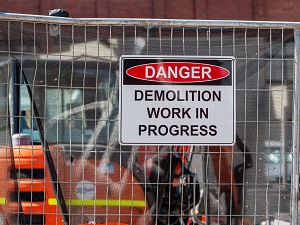
Demolition work involves many of the same hazards that are common during construction activities, but demolition may also introduce additional hazards like lead-based paint, sharp objects, and asbestos-containing material.
During demolition projects there may be unknown factors that can pose risks to workers such as:
- Changes and modifications that have altered the original design of the building
- Materials hidden within structural members like lead, asbestos, silica, chemicals, heavy metals, or other hazardous materials that may require special handling
- Unknown strengths or weaknesses of damaged materials
- Hazards created by the demolition methods used
Select and inspect personal protective equipment (PPE) before use. In demolition operations the PPE required may include:
- Eye, face, head, hand, and foot protection
- Respiratory protection
- Hearing protection
- Personal Fall Arrest Systems (PFAS)
- Additional protective clothing (for other operations like welding or asbestos removal)
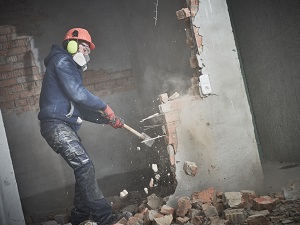
When debris from the demolition is dropped through holes in the floor without the use of chutes, the area where the material is dropped must be enclosed with barricades at least 42 inches high and at least 6 feet back from the projected edges of the opening above. Warning signs of the hazard of falling material must be posted at each level.
OSHA Standard 1926.852(a) No material shall be dropped to any point lying outside the exterior walls of the structure unless the area is effectively protected.
Floor openings used for material disposal must not be more than 25% of the total floor area. Material removal on the lower levels is not permitted until all demolition operations and debris handling above have stopped. Floors weakened or otherwise made unsafe by demolition operations must be shored to ensure they can safely carry the imposed load from the debris. Retaining walls that demolition debris will be piled against must be capable of supporting the potential load.
Use enclosed chutes with gates on the discharge end to drop demolition material to the ground or into debris containers. A substantial gate must be installed on each chute at or near the discharge end. Someone should be assigned to control the operation of the gate, and the backing and loading of trucks. Ensure that the chutes are constructed to be strong enough to handle the material. When operations are not in progress, the area surrounding the discharge end of a chute must be securely closed off.
OSHA Standard 1926.252(a) Whenever materials are dropped more than 20 feet to any exterior point of a building, an enclosed chute must be used.
All chute openings must be protected by a substantial guardrail about 42 inches above the floor or other surface on which the workers stand to dump the material. Any space between the chute and the edge of openings in the floors through which it passes must be solidly covered over.
Where the material is dumped from mechanical equipment or wheelbarrows, a securely attached toeboard or bumper, at least 4 inches thick and 6 inches high, must be provided at each chute opening.
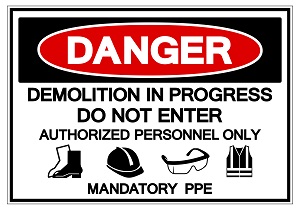
Demolition of exterior walls and floors must begin at the top of the structure and proceed downward. All roof cornices and ornamental stonework must be removed before pulling walls down.
Floor openings within 10 feet of any wall being demolished must be planked solid, except when workers are kept out of the area below.
Steel construction must be dismantled column length by column length, and tier by tier (columns may be in two-story lengths). When pulling over walls, or portions of walls, all steel members affected must have already been cut free. Masonry walls, or other large sections of masonry, should not fall onto the floor in such a way that would exceed the load capabilities of the floor.
OSHA Standard 1926.854(a) Masonry walls, or other sections of masonry, shall not be permitted to fall upon the floors of the building in such masses as to exceed the safe carrying capacities of the floors.
No wall section, which is more than one story in height, can stand alone without lateral bracing, unless the wall was originally designed and constructed to stand without such lateral support, and is in a condition safe enough to be self-supporting. All walls must be left in a stable condition at the end of each shift.
Workers are not permitted to work on the top of a wall when weather conditions constitute a hazard. Walkways or ladders must be provided to enable workers to safely reach or leave any scaffold or wall. Walls, which serve as retaining walls to support earth or adjoining structures, cannot be demolished until the ground has been properly braced or until the structures have been properly underpinned.
OSHA Standard 1926.854(d) Structural or load-supporting members on any floor must not be cut or removed until all stories above that floor have been removed.
In buildings of “skeleton-steel” construction, the steel framing may be left in place during the demolition of masonry. Where this is done, all steel beams, girders, and similar structural supports must be cleared of all loose material as the masonry demolition progresses downward.

During demolition it is critical that the floors be able to withstand the weight of the debris, materials, and equipment as the work progresses.
OSHA Standard 1926.857(a) The storage of waste material and debris on any floor shall not exceed the allowable floor loads.
In buildings with wooden floor construction, the flooring boards may be removed from only one floor above grade to provide storage space for debris, provided falling material does not become a danger to the stability of the structure.
When wood floor beams serve to brace interior walls or free-standing exterior walls, these beams must be left in place until other equivalent support can be installed to replace them.
Floor arches, to an elevation of not more than 25 feet above grade, may be removed to provide storage area for debris as long as this removal does not endanger the stability of the structure.
Storage space into which material is dumped must be blocked off, except for openings necessary for the removal of material, and these openings must be kept closed at all times when material is not being removed.
Mechanical equipment can not be used on floors or working surfaces unless the floors or surfaces are of sufficient strength to support the imposed load.

Safe passage throughout the work area must be maintained for all personnel. Inspect and maintain all stairs, passageways, and ladders. Properly illuminate all stairways. Put up barricades to prevent unauthorized persons from entering the work area. Post signs at each level of the structure(s) that warn of the hazard of falling materials. Curbs or stop-logs must be placed around floor openings to prevent equipment from running over the edge.
OSHA Standard 1926.851(a) Only those stairways, passageways, and ladders, designated as means of access to the structure of a building, shall be used. Other access ways shall be entirely closed at all times.
Fire or explosion can be serious risks at demolition sites and all potential sources of ignition should be identified before work begins. A fire protection program must be in place during demolition and appropriate firefighting equipment, like fire extinguishers, must be available.
OSHA Standard 1926.150(a)(1) The employer shall be responsible for the development of a fire protection program to be followed throughout all phases of the construction and demolition work and shall provide for the firefighting equipment. As fire hazards occur, there shall be no delay in providing the necessary equipment.
Firefighting equipment must be easy to find, readily accessible, and maintained at all times. Ensure the Fire Department can gain access to the job site and fire hydrants, if needed. Smoking, open flames, and any operations that can produce sparks must be restricted to limited, specific, safe areas. A fire warning system should be in place to ensure workers can quickly and safely evacuate in the event of a fire.
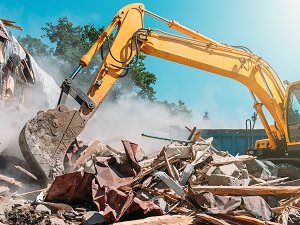
Using heavy equipment and utility vehicles for tasks such as demolishing, abrading, or fracturing silica-containing materials like brick, block, and concrete can generate respirable crystalline silica dust. When inhaled, the small particles of silica can irreversibly damage the lungs.
Operator isolation inside the heavy equipment cab and wet methods for dust suppression are two ways to protect workers on demolition job sites from hazardous silica dust.
Operators using heavy equipment and utility vehicles must stay inside an enclosed cab with the doors and windows closed while work is in progress. The cab must be well-sealed and well-ventilated, using positive pressure.
If other workers are present in the area, water and/or dust suppressants must be applied as necessary to minimize visible dust. Wet methods may include:
- Tank trucks equipped with hoses and nozzles that spray water or other dust suppressants over large areas to wet the materials disturbed during tasks.
- A worker who assists the operator by applying water or other types of dust suppressants to materials being demolished, abraded, or fractured.
- Large atomized misting devices.
- Spray equipment attached directly to the vehicle.
No workers are permitted in the area when using a crane’s headache ball or clamshell to remove debris. Only those workers necessary to perform these operations are allowed in this work area at any time. The weight of the demolition ball must not exceed 50 percent of the crane’s rated load.
The crane boom and loadline must be as short as possible. The ball must be attached to the loadline with a swivel-type connection to prevent twisting of the loadline, and it must be attached by positive means in such a manner that the weight cannot become accidentally disconnected.
OSHA Standard 1926.859(a) No workers shall be permitted in any area, which can be adversely affected by demolition operations, when balling or clamming is being performed. Only those workers necessary for the performance of the operations shall be permitted in this area at any other time.
During demolition, regular inspections must be conducted as the work progresses to detect hazards resulting from weakened or deteriorated floors, or walls, or loosened material. No work is permitted where structural collapse hazards exist until they are corrected by shoring, bracing, or other effective means.
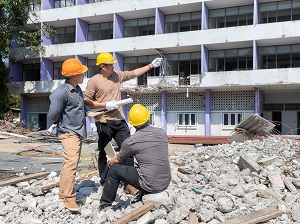
.jpeg)

